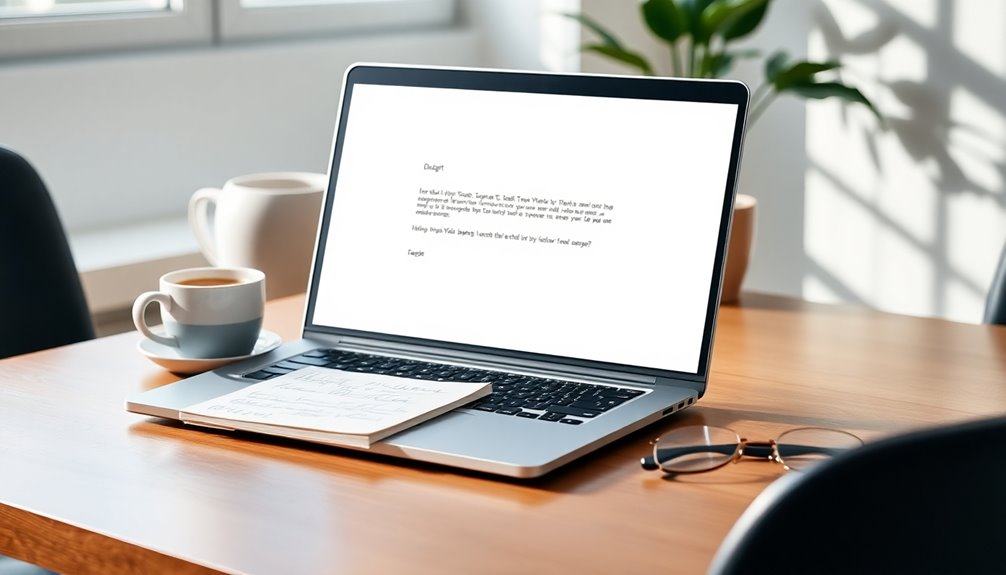To write a compelling press release email to media outlets, start with a concise subject line that highlights the story’s relevance. Lead with a strong, attention-grabbing headline in the body and immediately explain why the story matters to their audience. Use clear, straightforward language, keep paragraphs short, and include key resources like images or links. Personalize your message if possible, and emphasize what makes your story newsworthy—continue if you want to learn how to craft an impactful email step-by-step.
Key Takeaways
- Craft a compelling, concise subject line under 10 words that highlights the story’s relevance.
- Start with a strong headline and a brief summary of the newsworthiness in the email body.
- Use clear, active language, short paragraphs, and bullet points to make the message easy to scan.
- Personalize the email by referencing the journalist’s previous work or interests to increase engagement.
- Include all relevant resources like press kits, images, or videos and end with a clear call to action.

Are you wondering how to craft a compelling press release email that grabs attention and gets your news noticed? The key to effective media outreach starts with your email’s subject line. Think of it as your first impression—if it doesn’t pique curiosity or clearly communicate value, journalists won’t bother opening it. Keep your subject lines concise, ideally under 10 words, and include keywords that immediately signal the story’s relevance. For example, if you’re announcing a new product, something like “Innovative Tech Launch to Transform Education” immediately tells the recipient why it matters. Personalization also plays a role; mentioning the journalist’s name or referencing their previous work can boost open rates. Avoid generic subject lines like “Press Release” or “News Update,” which often get ignored or deleted.
Once your email is opened, you need to quickly establish why your story matters. Journalists receive hundreds of emails daily, so your message needs to be clear and compelling right from the start. Lead with a strong, attention-grabbing headline in the body of your email that complements your subject line. Keep it brief but impactful, summarizing the most newsworthy aspect of your story. Follow this with a concise paragraph that outlines the who, what, when, where, why, and how. Be direct about why this story is relevant to their audience and how it aligns with their beat. Remember to answer the question: why should they care? The more you can connect your news to current industry trends or issues, the more likely it is to resonate. Incorporating elements of hamster care and costs can add a practical dimension that makes your story more tangible and appealing.
Throughout your email, maintain an active voice and use language that’s engaging and straightforward. Avoid jargon or overly technical terms unless absolutely necessary. Make your email easy to skim by using short paragraphs and bullet points if needed. Include a clear call to action—whether it’s scheduling an interview, requesting more information, or linking to additional resources. Don’t forget to attach or include links to press kits, images, or videos that can help journalists craft their stories. Lastly, personalize your outreach as much as possible; referencing the journalist’s previous articles or interests shows you’ve done your homework and respect their work. When your media outreach is targeted and your email subject lines are compelling, you markedly increase your chances of cutting through the noise and securing media coverage.
Frequently Asked Questions
How Do I Target the Right Media Outlets for My Press Release?
You target the right media outlets by doing thorough media research and audience segmentation. First, identify outlets that align with your industry and message. Then, analyze their audiences to guarantee your press release resonates with their interests. Focus on outlets that reach your target demographic, increasing your chances of coverage. Tailoring your approach based on research helps you connect with the right journalists and editors, making your press release more effective.
What’s the Ideal Timing to Send a Press Release Email?
Think of your press release email like catching the early bird—timing considerations matter. The best sending time is generally Tuesday to Thursday mornings, when journalists are most receptive. Studies show emails sent mid-morning have higher open rates. Avoid weekends or late afternoons, when your message might get lost. By choosing the right moment, you increase your chances of your news getting noticed and covered.
How Should I Follow up if I Don’T Receive a Response?
If you don’t get a response, wait about a week before following up, respecting media etiquette. Send a polite, concise message that references your original email and reiterates your story’s newsworthiness. Keep your follow-up brief and professional, emphasizing your willingness to provide additional information. Remember, timing is key—avoid rushing or pestering, and give journalists enough space to respond while demonstrating your respect for their workflow.
What Are Common Mistakes to Avoid in Press Release Emails?
Imagine sending a press release with a casual tone—news outlets might overlook it, thinking you lack professionalism. Avoid common mistakes like using a too-salesy press release tone or neglecting media contact etiquette. Make your email concise, clear, and respectful. Don’t forget to personalize your message and proofread thoroughly. These small details help guarantee your press release gets noticed, rather than ignored or misunderstood.
How Do I Personalize My Email Without Sounding Generic?
To personalize your email without sounding generic, use personalization tactics like addressing the journalist by name and referencing their previous work. Mention specific reasons why your press release aligns with their interests, avoiding clichés like “I hope this email finds you well.” Show genuine knowledge of their beat or publication, which makes your pitch more relevant and engaging without sounding rehearsed.
Conclusion
Now that you know how to craft an effective press release email, are you ready to grab the media’s attention and make your news stand out? Remember, keep it clear, concise, and engaging, and always tailor your message to your audience. With a well-written email, you can open doors to new opportunities and boost your visibility. So, why not start drafting that perfect press release email today and see where it takes you?
Natali – Editor in Chief (Strategy and Mastery, AI Expert) Natali, our Editor in Chief, is the driving force behind our content’s strategic direction. With a keen eye for detail and a deep understanding of market trends, Natali ensures that our content is top-notch and strategically aligned with our client’s goals. Her expertise in AI helps to seamlessly integrate advanced technology into our marketing strategies, pushing the boundaries of conventional marketing.










